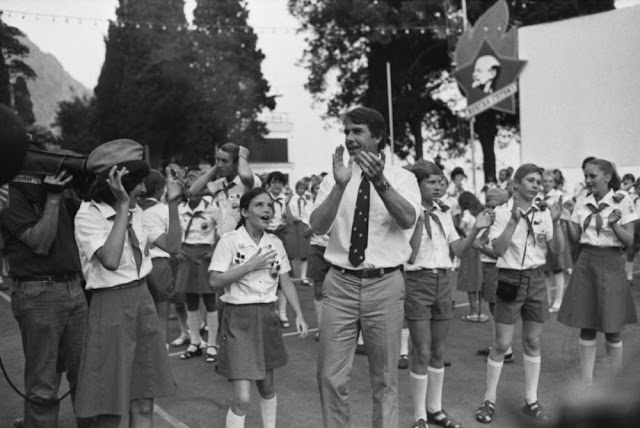In late 1982, Samantha Reed Smith, a fifth grader from Manchester, Maine, wrote a plaintive letter to Soviet leader Andropov. She said that she was “worrying about Russia and the United States getting into a nuclear war. Are you going to have a war or not?”
A few months later, Smith’s letter was reprinted in Russia and it was announced that Andropov was writing a response. Smith received his letter in April 1983. Andropov assured Smith that he did not want a nuclear war with the United States or any other country. Calling Smith a “courageous and honest” little girl, Andropov closed the letter with an invitation for her to visit the Soviet Union.
In July, accompanied by her parents, Smith embarked on a two-week trip. She was a hit in the Soviet Union, and although she did not get to meet with Andropov, she traveled widely and spoke to numerous groups and people.
Smith pursued her role as a media celebrity when in 1984, billed as a “Special Correspondent,” she hosted a children’s special for the Disney Channel entitled Samantha Smith Goes To Washington: Campaign ’84. The show covered politics, where Smith interviewed several candidates for the 1984 presidential election. In 1985, she played the co-starring role of the elder daughter to Robert Wagner’s character in the television series, Lime Street.
On August 25, 1985, Smith and her father were returning home aboard Bar Harbor Airlines Flight 1808 after filming a segment for Lime Street. While attempting to land at Lewiston-Auburn Regional Airport in Auburn, Maine, the Beechcraft 99 commuter plane struck some trees 4,007 feet (1,221 m) short of the runway and crashed, killing all six passengers and two crew on board.
Samantha Smith was mourned by about 1,000 people at her funeral in Augusta, Maine, and was eulogized in Moscow as a champion of peace. Attendees included Robert Wagner and Vladimir Kulagin of the Soviet Embassy in Washington, D.C., who read a personal message of condolence from Mikhail Gorbachev.


 |
| Samantha Smith with letter from Andropov. |
 |
| Smith’s mother later said that the trip to the Soviet Union changed her daughter, noting how much maturity she gained in one summer. Samantha Smith later wrote that the most important outcome of her journey was the understanding that people around the world are not strangers, but are neighbors. |
 |
| Samantha Smith flew to the Crimean Peninsula from Moscow. At the airport in Simferopol, she was met by children from the camp who taught her to sing a number of popular songs. |
 |
| Smith with her father, surrounded by children and journalists. Her last day at Artek was also the end of the camp session. She recalled that processions, dances, masquerades, and fireworks created a great spectacle. |
 |
| The guest from the United States was greeted at Artek with dances and karavai, which is traditional bread and a symbol of hospitality. She said she was speechless as an orchestra played for her and children chanted her name. |
 |
| On a boat tour with her new Soviet friends off the Crimean coast. |
 |
| On a boat tour with her new Soviet friends off the Crimean coast. |
 |
| Natasha Kashirina (third from right) and Smith (center) at the camp’s Neptune Festival. Smith said there were swimming competitions, a theatrical performance on the water, laughter, jokes, and, in the end, the children threw their counselors into the sea. |
 |
| Her Soviet hosts paired up Smith with Natasha Kashirina, who spoke English because her mother taught the language. The two became friends and continued to communicate even after the end of the camp visit. In the early 1990s, Kashirina, together with Olga Sakhatova, traveled to the United States to work as counselors at the Samantha Smith Camp, organized by her mother. There, Kashirina met her future husband and subsequently moved to live in California. |
 |
| Olga Sakhatova, a counselor at Artek’s Morskoi camp, recalled that not everyone was happy about the visit. She said the camp was often shown off to foreign visitors, and it required intensive cleaning to make sure they made the best impression. |
 |
| According to Smith, she never felt lonely during her three days at Artek, saying she made a lot of friends. |
 |
| The Soviet campers asked Smith about life in the United States, especially about clothes and music. She said that in the evenings they sometimes talked about war and peace, and she learned that almost everyone she met at Artek had relatives who had been killed in World War II. She concluded that, if war can destroy everything, the most important thing is never to fight. |
 |
| Smith said she really liked her uniform at Artek and asked to keep it as a souvenir. Sakhatova said she felt great affection for Smith but was concerned because the cost of “lost” uniforms was usually deducted from staff salaries. Arrangements were later made for Smith to receive the uniform as a gift. |
 |
| 1985 USSR stamp with “Samant[h]a Smit[h]” in Cyrillic. |




























0 comments:
Post a Comment